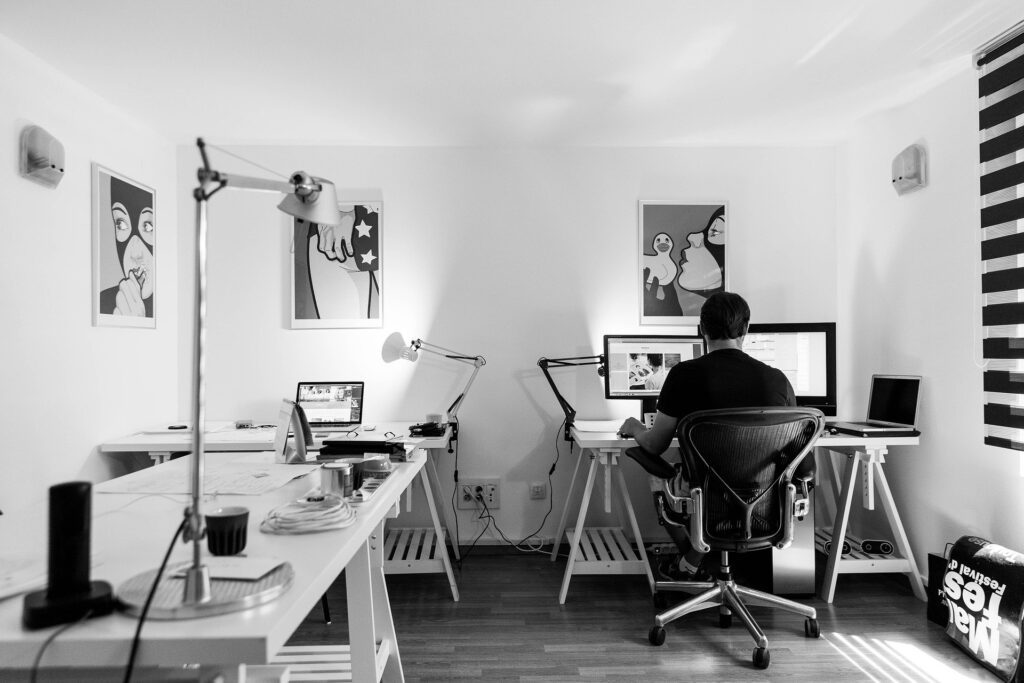Welcome to the topic of “Business Use of Home.”
During the pandemic, more Americans began to think more about working from home and becoming entrepreneurs in their own right. Putting your thoughts and ideas to action is one thing, but understanding the tax implications are another. Did you know that you can deduct certain home business expenses?

Business Use of Home Expenses
Some expenses are deductible whether or not you use your home for business. Others are deductible only if the home is used for business.
Deductible Regardless
• Real estate taxes.*
• Mortgage interest.*
• Home equity interest.*
• Casualty losses.*
• Qualified mortgage insurance premiums.*
Deductible Only If for Business**
• Homeowner’s insurance .
• Rent.
• Repairs and maintenance .
• Security system.
• Utilities and services.
• Depreciation (deductible after applying deduction limitation to above expenses).
- Deductible as an itemized deduction, subject to limitation.
** Deductible as a business expense pro-rated for the amount of the business use of the home
What are some types of Home Expenses?
Direct Expenses
Expenses that benefit only the area exclusively used for business, such as painting or repairs in the home office, are direct expenses that are fully deductible.
Indirect Expenses
Expenses for keeping up and running the entire home, such as insurance, utilities, and general repairs, are indirect expenses that are deductible based on the percentage of the home used for business.
Unrelated Expenses
Expenses for the part of the home not used for business, such as lawn care or painting a room not used for business, are unrelated expenses that are not deductible.
Telephone
The basic local telephone service for the first telephone line is nondeductible even if it is used for business. Any additional charges for long distance or a second line into the home used for business are deductible. Any deductible telephone costs are not included as
business use of home cost.
Depreciation
A qualified home office is considered nonresidential real property depreciable over 39 years. For home office depreciation, the basis in the home is the smaller of:
• The fair market value (FMV) of the home minus the FMV of land on the date the home was first used for business, or
• The home’s cost plus permanent improvements minus casualty losses minus the cost of land on the date the home was first used for business.
Home Improvements
Permanent improvements prior to using the home for business are added to the basis of the home and depreciated as part of the adjusted basis of the home. The cost of improvements made after using the home for business that affect the area of the home used for business are depreciated separately.

Calculating Business Use of Home Deduction
Business Percentage
The business percentage equals the area of the part of the home used for business divided by the area of the whole house. Any reasonable method may be used to determine the business percentage.
The following are two common methods.
• Divide square footage of area used for business by total square footage of home.
• If all rooms are about the same size, divide the number of
rooms used for business by total number of rooms in the home.
Part-Year Use
Do not include home expenses in the business use equation for any period during the year where the home was not used for business.
Day Care Facility
The business percentage of an area exclusively used for business in a day care facility is calculated under the business percentage method above. For the portion of the home regularly used, but not exclusively used for the day care business, multiply that portion by the business percentage of time.
Did You Know?
In many cases, the basement and garage may be included in the total square footage of a day care provider’s home when calculating the business use percentage. In addition to regularly used rooms, the business use area can include:
• Entryways, halls, food preparation areas, and bathrooms.
• Basement with laundry or tool rooms, storage or furnace area, etc.
• Garage where business car is parked or where household tools, trash cans, or stored day care items are kept.
Calculating Time Spent on Day Care
You should keep a log reflecting time spent conducting the day care business, including dates and hours each person was in your care, and additional time spent organizing, pre paring meals, and cleaning up.
Deduction Limitation
The business use of home deduction is limited to net in come from the business.
Carryover of Un-allowed Expenses
Deductions not allowed due to the net income limitation are carried over to the following year. They are added to current expenses from each category and subject to the deduction limit for that year for that category, whether or not you live in the same home during that
year.
Simplified Option for Home Office Deduction
The simplified option for the home office deduction may be calculated as follows:
• A standard deduction is allowed of $5 per square foot of home used for business, limited to 300 square feet.
• Allowable home-related itemized deductions such as mortgage interest and real estate taxes are claimed in full on Schedule A, instead of apportioned between the business form and
Schedule A.
• No home depreciation deduction is claimed and no later recapture of depreciation is required for the years the simplified method is used.
Conclusion
You can now confidently deduct your home business expenses.
Also read: Delving Into Tax Returns




